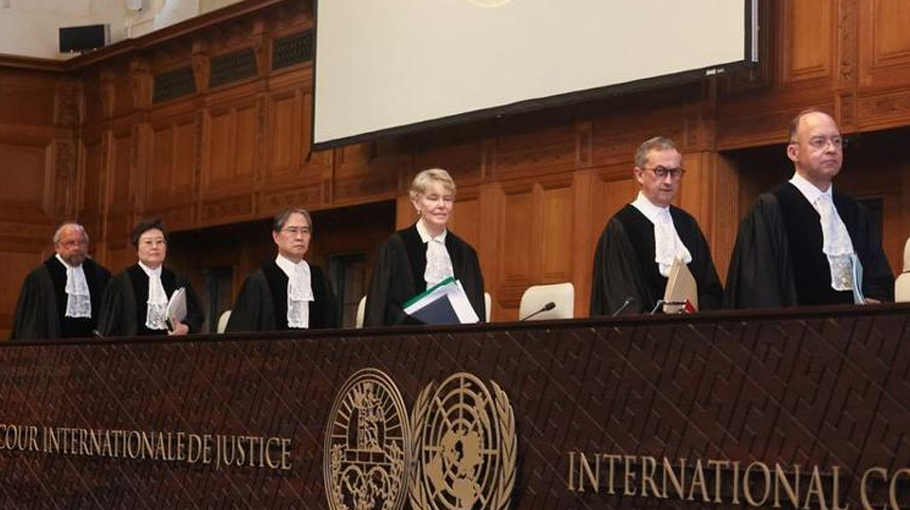Fierce fighting rocks northern Gaza as Israel defends itself at ICJ

Israeli forces battled Hamas fighters in the narrow alleyways of Jabalia in northern Gaza on Friday in some of the fiercest engagements since they returned to the area a week ago, while in the south militants attacked tanks massing around Rafah.
Residents said Israeli armour had thrust as far as the market at the heart of Jabalia, the largest of Gaza’s eight historic refugee camps, and that bulldozers were demolishing homes and shops in the path of the advance.
As fighting raged in the north and south of the territory, the U.S. military said trucks carrying humanitarian assistance had started moving ashore from a temporary pier in Gaza on Friday morning.
“Israel’s focus is Jabalia now, tanks and planes are wiping out residential districts and markets, shops, restaurants, everything. It is all happening before the one-eyed world,” said Ayman Rajab, a resident of western Jabalia.
“Shame on the world. Meanwhile, the Americans are going to get us some food,” Rajab, a father-of-four, told Reuters via a chat app. “We want no food, we want this war to end and then we can manage our lives on our own.”
Israel had said its forces had cleared Jabalia months earlier in the Gaza war, triggered by the deadly Hamas-led attacks on southern Israel on Oct. 7, but said last week it was returning to prevent the Islamist group re-establishing itself there. The fighting has coincided with the assault on Rafah at the southern edge of the strip, sending hundreds of thousands of people fleeing from both ends of the territory at once.
At the World Court in The Hague, Israel asked judges to throw out a demand from South Africa for an emergency order to halt the assault on Rafah and withdraw Israeli troops from all of Gaza.
HUMANITARIAN FEARS
The Israeli Defense Forces (IDF) said in a statement its troops had killed more than 60 militants in recent days and located a weapons warehouse close to a shelter complex in what it described as a “divisional-level offensive” in Jabalia.
A divisional operation would typically involve multiple brigades of thousands of troops each, making it one of the biggest of the war.
“Even now, the soldiers are exchanging fire with terrorist cells in the area,” the IDF said. “The 7th Brigade’s fire control centre directed dozens of airstrikes, eliminated terrorists and destroyed terrorist infrastructure.”
Despite seven months of near-continuous fighting, armed wings of Hamas and its ally Islamic Jihad have been able to fight up and down the Gaza Strip, using heavily fortified tunnels to stage attacks, highlighting the difficulty of achieving Israeli Prime Minister Benjamin Netanyahu’s stated aim of eradicating the militant group.
At least 35,303 Palestinians have now been killed in the war, according to figures from the enclave’s health ministry, while aid agencies have warned repeatedly of widespread hunger and the threat of disease.
Doctors complain they have to perform surgery, including amputations, with no anaesthetics or painkillers as the medical system in the territory has virtually collapsed.
Israel says it must complete its objective of destroying Hamas for its own safety after the deaths of 1,200 people on Oct. 7, and to free the 128 hostages still held out of 253 abducted by the militants, according to its tallies.
To achieve that, it says it must capture Rafah, Gaza’s southernmost city bordering Egypt, where around half of the territory’s 2.3 million people had sought shelter from the fighting further north.
Israel’s operation against Rafah, which began in early May but has yet to escalate to an all-out assault, has ignited one of the biggest rifts in generations with its main ally, the United States. Washington held up a weapons shipment over fears of civilian casualties.
Underlining concerns among other Western nations that have generally backed Israel, a letter seen by Reuters on Friday and signed by more than a dozen democracies, including all members of the G7 apart from the U.S., urged Israel to comply with international humanitarian law in Gaza.
‘TRAGIC WAR’
Israeli tanks and warplanes bombarded parts of Rafah on Friday, while the armed wings of Hamas and Islamic Jihad said they were firing anti-tank missiles and mortars at forces massing to the east, southeast and inside the Rafah border crossing with Egypt.
The UNRWA, the main U.N. aid agency for Palestinians, said that since the military offensive on Rafah started on May 6, more than 630,000 people have been forced to flee Rafah.
“Many have sought refuge in Deir al-Balah, which is now unbearably overcrowded with dire conditions,” it added. Deir al-Balah, up the coast from Rafah to the north, is the only other city in Gaza yet to be assaulted by Israeli forces.
At the International Court of Justice, or World Court, in The Hague, where South Africa has accused Israel of violating the Genocide Convention, Israeli Justice Ministry official Gilad Noam defended the operation.
Noam said Israel was fighting a war of self-defence and that the military operation in Rafah was not aimed at civilians but at dismantling the last Hamas stronghold.
“There is a tragic war going on, but there is no genocide” in Gaza, Noam said.
The South African legal team, which set out its case for fresh emergency measures the previous day, framed the Israeli military operation as part of a genocidal plan aimed at bringing about the destruction of the Palestinian people.




